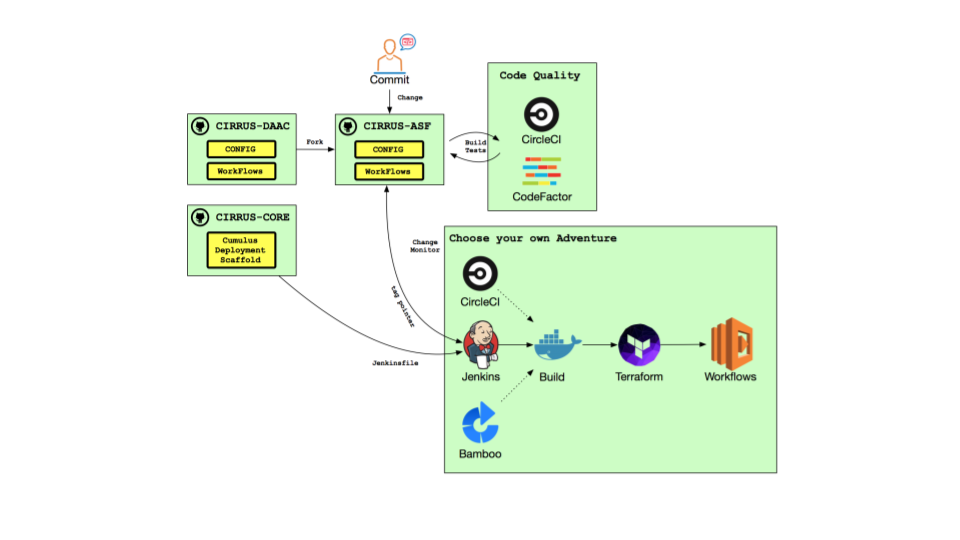This repository contains the configuration and deployment scripts to deploy Cumulus Core for a DAAC. All parts of the deployment have been Terraformed and the configuration minimized by using outputs from other modules and lookups using Terraform AWS provider data sources.
The project contains a Makefile and CI/CD configuration for Jenkins, CircleCI, and Bamboo. By configuring a job for one of those CI/CD providers, CIRRUS core can deploy a DAAC-specific Cumulus configuration that has been derived from CIRRUS-DAAC.
See the Cumulus Documentation for detailed information about configuring, deploying, and running Cumulus.
- Docker
- One or more NGAP accounts (sandbox, SIT, ...)
- AWS credentials for those account(s)
Set DAAC_DIR as an enviroment var:
$ export DAAC_DIR=$HOME/projects/acme-cumulus
Here DAAC_DIR is the absolute path to the fork of CIRRUS-DAAC that
you would like to deploy.
If DAAC_DIR is not set, make will give you the following error:
make: *** Makefile: Not a directory. Stop.
make: *** [Makefile] Error 2
You can start an interactive Docker container session and use this to run tests and deploy the stack:
$ make image
$ make container-shell
The repository is organized into three Terraform modules:
tf: Creates resources for managing Terraform statedata-persistence: Creates DynamoDB tables and Elasticsearch resources necessary for running Cumuluscumulus: Creates all runtime Cumulus resources that can then be used to run ingest workflows.
You won't need to change anything in this project. The Terraform configuration in these directories remain the same for any Cumulus deployment.
To deploy your own Cumulus stack, first fork the
CIRRUS-DAAC repository and
rename it for your deployment. For example, you might name it
ASF-Cumulus. Next, customize the Terraform and variable settings in
your new CIRRUS-DAAC-forked repository. See its
README
for more details.
You can use CIRRUS-core to deploy multiple Cumulii to one account, and
to multiple accounts. Each instance of a Cumulus deployment is named
by providing a "Deploy Name" and a "Maturity". The Deploy Name is any
string that helps you identify the purpose of the Cumulus stack. The
Maturity is the environment for which it's configured. For example,
you may have an dev maturity for your development team's integration
environment.
When choosing values for MATURITY and DEPLOY_NAME:
- The combined length cannot exceed 12 characters
- Must consist of
a-z(lower case characters),0-9, and-(hyphen) only
The name of the Cumulus stack will be
DEPLOY_NAME-cumulus-MATURITY. For example, asf-cumulus-dev. By
changing the DEPLOY_NAME you can deploy multiple Cumulus stacks to one
account.
-
Create AWS Secret for TEA access with the named AWS Profile that has permissions to deploy to the target NGAP account:
$ source setup_jwt_cookie.sh <profile-name> <deploy-name> <maturity> e.g., to create a secret for XYZ DAAC's NGAP sandbox account with the initials of a developer (to make the deployment unique) and a maturity of 'dev': $ source setup_jwt_cookie.sh xyz-sandbox-cumulus kb dev (This assumes we've setup a named AWS credentials profile with the name `xyz-sandbox-cumulus`) **NOTE**: this script is still a WIP and may not work in all environments, contributions are welcome! -
Start the Docker container as shown above (
... make container-shell), providing theDAAC_DIRvariable you are working with. -
Setup your environment with the named AWS Profile that has permissions to deploy to the target NGAP account:
$ source env.sh <profile-name> <deploy-name> <maturity> e.g., to deploy to the XYZ DAAC's NGAP sandbox account with the initials of a developer (to make the deployment unique) and a maturity of 'dev': $ source env.sh xyz-sandbox-cumulus kb dev (This assumes we've setup a named AWS credentials profile with the name `xyz-sandbox-cumulus`) -
See the CIRRUS-DAAC README's instructions for creating local secrets files. These will be files located in the DAAC directory, and as the note describes below, are NOT to be checked in to git!
Important Note: This is only for local commandline deployment! For
example, deploying from a developer workstation. Normally these
secrets would be provisioned in and provided by a CI/CD service. See
details below on how to do this for Jenkins, CircleCI, and Bamboo. The
secrets files will not (and should not) be committed to git. The
.gitignore file will ignore them by default.
-
Deploy Cumulus. If this is your first Cumulus deployment for this stack, deploy the entire Cumulus stack:
$ make initial-deploy
This will deploy the Terraform modules that provision Terraform state resources, DAAC-specific resources, the Cumulus
data-persistencemodule, thecumulusmodule, therdsmodule, andworkflows.
If you want to deploy everything besides the rds module you can run the command:
$ make all
-
Deploy a specific part of the stack: If you're adding a new workflow, Lambdas, or other resources for your workflow, and the rest of the Cumulus deployment hasn't changed, just deploy the workflows:
$ make workflows -
Deploying any part of the stack. You can deploy any part of the Cumulus stack by running one of the targeted commands:
$ make tf $ make daac $ make rds $ make data-persistence $ make cumulus $ make workflows -
Any time you are upgrading a Cumulus stack please review the Cumulus and CIRRUS migration instructions (if any). The Cumulus instructions are generally included in the release notes. CIRRUS instructions would be included in the CHANGELOG for CIRRUS-core and CIRRUS-DAAC.

